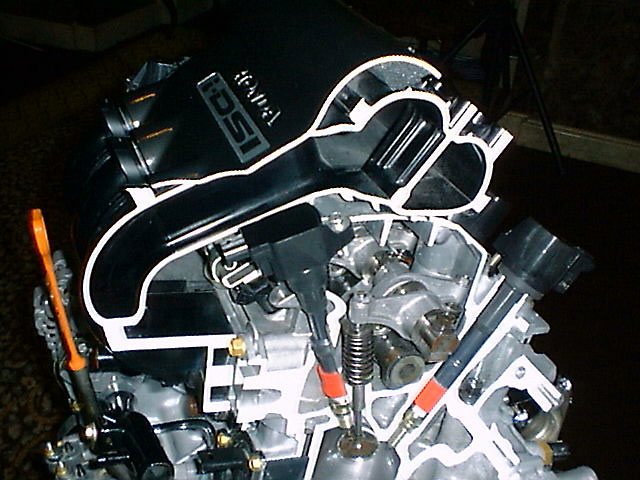The dua
 l sequential ignition system optimizes the timing of each spark plug based on engine speed and engine load. The intensive combustion at all engine speeds not only controls knocking, but also permits a much higher compression ratio (10.8:1) to achieve a higher output with less fuel consumed compared to a conventional design.
l sequential ignition system optimizes the timing of each spark plug based on engine speed and engine load. The intensive combustion at all engine speeds not only controls knocking, but also permits a much higher compression ratio (10.8:1) to achieve a higher output with less fuel consumed compared to a conventional design.Key to the i-DSI engine is rapid, intensive combustion, using two spark plugs in each cylinder mounted diagonally opposite one another, and a very compact, high-swirl combustion chamber made possible by the narrow (30°) valve angle and SOHC single pivot cylinder head.
Each pair of spark plugs is fired sequentially with the interval between the two depending on engine rpm and load. The intake side plug ignites first, then as the flame propagates, the exhaust side plug is fired (before top-dead-centre), and the flame expands rapidly into the whole area to achieve complete combustion. This arrangement provides much faster combustion and higher cylinder pressures to provide high engine output.
The programming of the ignition timing map achieves a careful balance between economy and power output. At large throttle openings, up to engine speeds of around 2600rpm, intake side ignition is advanced and the exhaust side slightly retarded. In the mid-range the exhaust side is further retarded, optimising output. At high engine speeds ignition is almost simultaneous for optimum power and torque. At part-throttle, the simultaneous ignition phase is more extensive, commencing as low as 3500 rpm. official website at http://www.honda.co.nz/site/technology for details.
Top torque, effortless economy
The intelligentl
 y-controlled, intensive combustion delivers class-leading levels of fuel economy, yet torque and power are improved across all engine speeds, especially in the low and middle ranges. As a result, the Jazz demonstrates a remarkably flat torque curve.
y-controlled, intensive combustion delivers class-leading levels of fuel economy, yet torque and power are improved across all engine speeds, especially in the low and middle ranges. As a result, the Jazz demonstrates a remarkably flat torque curve.Peak power output of the 1339cc engine is 61kW (83 PS) at 5700 rpm, and maximum torque is 119 Nm at just 2600 rpm. Significantly, approximately 90% of the maximum torque is available at between 2000 and 5000 rpm. Superb flexibility and lively performance are the results, and the engine is particularly well-suited to the optional CVT automatic transmission
Tidak ada komentar:
Posting Komentar